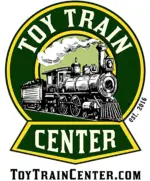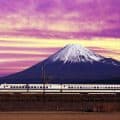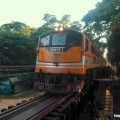Trains have come on leaps and bounds the past half-century while the maximum speed has almost quadrupled. Who knows how fast they will be able to go in another 50 years? They have exploded to now have so much more raw horsepower (hp) than they ever did before.
Horsepower is the power that one horse gives while pulling, more accurately its the power need to raise 500 pounds 1 foot high in 1 second. Interestingly, one horse has a maximum of about 15 horsepower and a healthy person can produce about 1.2hp.
But how much horsepower do trains have? We’ll answer this question by looking at train types from a chronological point of view, from steam trains to Japan’s Shinkansen.
Photo source: Wikimedia Commons
Steam Trains
Because steam trains have such a long and varied history, their horsepower is quite hard to accurately calculate. The very first steam trains operated long before today’s sophisticated speed measuring tools. James Watt, the inventor of horsepower, first used this form of measurement to calculate how effective his steam engine was. He determined that his steam engine had the power of 5 draft horses, which very likely meant his train had about 50-75 horsepower. Comparatively, the Union Pacific trains owned a steam train called “Big Boy” which managed to reach as much as 7,000 horsepower in the mid-1800s.
You can read more about James Watt and the origin of horsepower on ScienceABC.
Diesel Trains
Diesel trains came next and were a nice step up from steam engines, but they didn’t last quite as long as steam engines before being largely fazed out by electric ones. The British Rail Class 03 Diesel locomotive was a very popular and reliable train in Great Britain. This train was able to output on average between 2,000-3,000 horsepower. They may not have been able to get quite as much horsepower as “Big Boy” once did, but this one was far more consistent. Whereas “Big Boy” hp output varied anywhere between 1,000-7,000 and required many workers to keep the engine fueled, the British diesel locomotive was much more reliable.
Electric Trains
The Diesel-Electric train followed next in the chronological history of train development. It was tremendously much faster and more powerful than its predecessor, with as much as 200% increase in horsepower. Being able to use two primary sources of power, it allowed for the maximum horsepower available to increase greatly. GE Transportation managed to create a Diesel-Electric locomotive called the GE AC6000CW that was capable of consistently putting out a whopping 6,000 horsepower. Just like the diesel engine before it, the electric hybrid was faster, more powerful, and much more reliable.
High Speed Trains
Last, came the Japanese bullet train. The Shinkansen from Japan completely changed the game. Japan Rail wanted to find a new way to connect Tokyo to all the other major cities quickly, and they succeeded. The N7000 series Shinkansen has a staggering 22,900 horsepower. It is in a complete league of its own when it comes to speed and raw power. Japan’s high-speed railway service is second to none. The N7000 is one of the most fascinating trains in history! You can read more about it here.
Obviously it’s no fair comparison to pit the original steam trains from the 1800s against Japan’s bullet trains, but it does highlight just how far we have come in such a short time. Just think, how fast could our trains travel in another 200 years? They are 3000% more powerful today than they were back in the 1800s, and even half that progress again could revolutionize travel and make the airplanes redundant when travelling on land.




